Complete Classical Piano Music
- p.1 (Aa - Al)
- p.2 (Al - At)
- p.3 (At - Ba)
- p.4 (Ba - Ba)
- p.5 (Ba - Ba)
- p.6 (Ba - Ba)
- p.7 (Ba - Ba)
- p.8 (Ba - Ba)
- p.9 (Ba - Ba)
- p.10 (Ba - Ba)
- p.11 (Ba - Be)
- p.12 (Be - Be)
- p.13 (Be - Be)
- p.14 (Be - Be)
- p.15 (Be - Be)
- p.16 (Be - Be)
- p.17 (Be - Be)
- p.18 (Be - Bo)
- p.19 (Bo - Br)
- p.20 (Br - Br)
- p.21 (Br - Bu)
- p.22 (Bu - Ch)
- p.23 (Ch - Ch)
- p.24 (Ch - Ch)
- p.25 (Ch - Ch)
- p.26 (Ch - Ch)
- p.27 (Ch - Cl)
- p.28 (Cl - Co)
- p.29 (Co - Cz)
- p.30 (Cz - Da)
- p.31 (Da - De)
- p.32 (De - De)
- p.33 (De - De)
- p.34 (De - Du)
- p.35 (Du - En)
- p.36 (En - Fo)
- p.37 (Fr - Ge)
- p.38 (Gi - Gr)
- p.39 (Gr - Gr)
- p.40 (Gr - Gu)
- p.41 (Gu - Ha)
- p.42 (Ha - Ha)
- p.43 (Ha - Ha)
- p.44 (Ha - He)
- p.45 (He - Hy)
- p.46 (Ia - Jo)
- p.47 (Jo - Ka)
- p.48 (Ka - Ko)
- p.49 (Ko - La)
- p.50 (La - Li)
- p.51 (Li - Li)
- p.52 (Li - Li)
- p.53 (Li - Ma)
- p.54 (Ma - Mc)
- p.55 (Mc - Me)
- p.56 (Me - Mo)
- p.57 (Mo - Mo)
- p.58 (Mo - Mo)
- p.59 (Mo - Mo)
- p.60 (Mo - Na)
- p.61 (Ne - Pa)
- p.62 (Pa - Pl)
- p.63 (Pl - Pr)
- p.64 (Pr - Ra)
- p.65 (Ra - Ra)
- p.66 (Ra - Ra)
- p.67 (Ra - Ri)
- p.68 (Ri - Ro)
- p.69 (Ro - Sa)
- p.70 (Sa - Sc)
- p.71 (Sc - Sc)
- p.72 (Sc - Sc)
- p.73 (Sc - Sc)
- p.74 (Sc - Sc)
- p.75 (Sc - Sc)
- p.76 (Sc - Sc)
- p.77 (Sc - Sh)
- p.78 (Sh - Sn)
- p.79 (Sn - St)
- p.80 (St - Sz)
- p.81 (Ta - Tc)
- p.82 (Tc - Tu)
- p.83 (Tu - Va)
- p.84 (Va - Va)
- p.85 (Va - Va)
- p.86 (Va - Va)
- p.87 (Va - Va)
- p.88 (Va - Va)
- p.89 (Va - Va)
- p.90 (Va - Va)
- p.91 (Va - Va)
- p.92 (Va - Va)
- p.93 (Va - Va)
- p.94 (Va - Va)
- p.95 (Va - Va)
- p.96 (Va - Va)
- p.97 (Va - Vi)
- p.98 (Vi - We)
- p.99 (We - Za)
- p.100 (Za - Zy)
- Next >
-
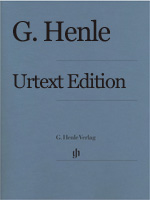
-
Liszt, Franz
Hungarian Rhapsody No. 1 (Jost/Eckhardt)
Liszt understood a "rhapsody" to signify the highest degree of musical freedom: a constant process of transformation and variation of themes and motifs, all bound up with constant shifts of emotion. According to one of its early reviewers, this first of Liszt's 19 Hungarian Rhapsodies is a prime example of "the art of thematic working such as no previous master has practised more fantastically, more expressively or more inventively." Despite this, it was somewhat overshadowed by the greater popul...
Read More
Category: Piano Solos
Item: 135204
Grade: Advanced
Price: $13.95
Availability: Ships in 10 to 15 Days - View Shopping Cart
-
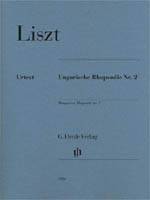
-
Liszt, Franz
Hungarian Rhapsody No. 2 (Jost)
Liszt's piano rhapsodies are in the same tradition as his transcriptions of opera or song themes, but in this case the point of departure is folk dances and songs. Liszt described no. 2 of his Hungarian Rhapsodies, published in 1851, as "truly Hungarian," and a "brilliant companion piece" to his own concert showpiece the Grand Galop chromatique. And indeed, the work, with its strong dynamic and harmonic contrasts, quickly became popular and remains among his best-loved keyboard works. The long-i...
Read More
Category: Piano Solos
Item: 134657
Grade:
Price: $17.95
Availability: Ships in 10 to 15 Days - View Shopping Cart
-

-
Liszt, Franz
Hungarian Rhapsody No. 2 (Bendel)
Category: Piano Solos
Item: 010202
Grade:
Price: $3.95
Availability: Ships in 6 to 9 Days - View Shopping Cart
-

-
Liszt, Franz
Hungarian Rhapsody No. 2 (Herttrich, et al)
Edited by Ernst Herttrich. Preface by Maria Eckhardt. Fingering by Andreas Groethuysen.
Category: Piano Solos
Item: 058761
Grade:
Price: $16.95
Availability: Ships in 6 to 9 Days - View Shopping Cart
-

-
Liszt, Franz
Hungarian Rhapsody No. 2, Theme from (Eckstein)
Category: Piano Solos
Item: 083709
Grade:
Price: $2.95
Availability: Ships in 6 to 9 Days - View Shopping Cart
-

-
Liszt, Franz
Hungarian Rhapsody No. 6 (Herttrich et al)
Edited by Ernst Herttrich. Preface by Maria Eckhardt. Fingering by Andreas Groethuysen.
Category: Piano Solos
Item: 059680
Grade:
Price: $12.95
Availability: Ships in 6 to 9 Days - View Shopping Cart
-

-
Liszt, Franz
Hungarian Rhapsody No. 9 - Carnival at Pest (Herttrich et al)
G. Henle URTEXT edition. Edited by Ernst Hettrich. Fingering by Andreas Groethuysen. Preface by Maria Eckhardt. Liszt's ninth Rhapsody is the "Carnival at Pest" - one of the few Hungarian Rhapsodies to which he gave a name. Once again Liszt turns to Hungarian folk melodies and fuses them with improvisatory elements. The result is a dazzling virtuosic firework display. The relaxed atmosphere of a Budapest carnival around 1840 is brought to life - indeed Liszt is said to have recorded several theme...
Read More
Category: Piano Solos
Item: 064508
Grade:
Price: $16.95
Availability: Ships in 6 to 9 Days - View Shopping Cart
-

-
Liszt, Franz
Hungarian Rhapsody No. 12 (Herttrich, et al)
G. Henle Urtext edition. Edited by Ernst Herttrich. Preface by Maria Eckhardt. Fingering by Andreas Groethuysen.
Category: Piano Solos
Item: 070105
Grade:
Price: $14.95
Availability: Ships in 6 to 9 Days - View Shopping Cart
-

-
Liszt, Franz
Hungarian Rhapsody No. 15 - Rakoczi March (Herttrich et al)
G. Henle urtext edition. Edited by Ernst Herttrich. Preface by Maria Eckhardt. Fingering by Andreas Groethuysen. The Rakoczi march is often referred to as the "Hungarian Marseillaise". The beginnings of this march song go back to around 1730. In the text, the Hungarians summon Franz II Rakoczi to free his people from the Habsburg oppression. The melody has been arranged many times, e. g. by Brahms and Berlioz, even Liszt made several arrangements of varying degrees of difficulty. He eventually di...
Read More
Category: Piano Solos
Item: 078447
Grade:
Price: $13.95
Availability: Ships in 6 to 9 Days - View Shopping Cart
-
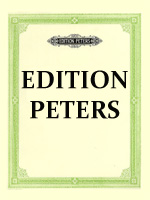
-
Liszt, Franz
Klavierwerke Band X
Category: Piano Composer Folios
Item: 029580
Grade:
Price: $31.50
Availability: Ships in 10 to 15 Days - View Shopping Cart
-

-
Liszt, Franz
Klavierwerke, v.1
Contents: Hungarian Rhapsodies Nos. 1-8.
Category: Piano Composer Folios
Item: 001393
Grade:
Price: $35.00
Availability: Ships in 10 to 15 Days - View Shopping Cart
-

-
Liszt, Franz
Klavierwerke, v.2
Contents: Hungarian Rhapsodies Nos.9-19.
Category: Piano Composer Folios
Item: 011528
Grade:
Price: $43.00
Availability: Ships in 10 to 15 Days - View Shopping Cart
-

-
Liszt, Franz
Klavierwerke, v.3
Contents: 12 Etudes d'Execution Transcendante.
Category: Piano Composer Folios
Item: 041425
Grade:
Price: $35.00
Availability: Ships in 10 to 15 Days - View Shopping Cart
-

-
Liszt, Franz
Klavierwerke, v.4 (Sauer)
Contents: Paganini Etudes; 5 Concert Etudes (Il lamento, La leggierezza, Un sospiro, Waldesrauschen, Gnomenreigen).
Category: Piano Composer Folios
Item: 084881
Grade:
Price: $30.00
Availability: Ships in 10 to 15 Days - View Shopping Cart
-
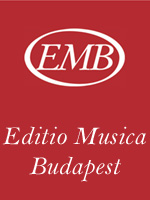
-
Liszt, Franz
La Campanella (sample page)
(sample page)
Category: Piano Solos
Item: 090027
Grade:
Price: $18.45
Availability: Ships in 6 to 9 Days - View Shopping Cart
-

-
Liszt, Franz
Legends (2) (Heinemann et al)
Edited by Ernst-Gunter Heinemann, Forward by Maria Eckhardt. Fingering by Jan Philip Schulze.
Category: Piano Solos
Item: 055902
Grade:
Price: $23.95
Availability: Ships in 6 to 9 Days - View Shopping Cart
-

-
Liszt, Franz
Les Jeux d'Eaux a la Villa d'Este (Herttrich/Theopold)
Category: Piano Solos
Item: 083020
Grade:
Price: $12.95
Availability: Ships in 6 to 9 Days - View Shopping Cart
-
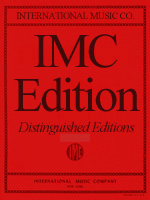
-
Liszt, Franz
Les Preludes, G.97 (Cameron)
Category: Piano Solos
Item: 067294
Grade:
Price: $30.00
Availability: Ships in 6 to 9 Days - View Shopping Cart
-

-
Liszt, Franz
Liebestraume (Weber/Friedman)
Category: Piano Solos
Item: 135824
Grade:
Price: $14.95
Availability: Ships in 6 to 9 Days - View Shopping Cart
-

-
Liszt, Franz
Liebestraume No 3 (Pauer)
Category: Piano Solos
Item: 024063
Grade:
Price: $3.95
Availability: Ships in 6 to 9 Days - View Shopping Cart
-

-
Liszt, Franz
Liebestraume No 3 (Juame)
Category: Piano Solos
Item: 011527
Grade:
Price: $3.95
Availability: Usually Ships in 24 Hours - View Shopping Cart
-

-
Liszt, Franz
Liebestraume No 3 - A Dream of Love (Robbins)
Franz Liszt (1811-1886), who is known for creating modern piano playing techniques and pioneered harmony and form of piano composition, published this piece as part of three piano solos. "A Dream of Love" or "Liebestraum" is actually the last in a set of three (No. 3) and the most renown masterwork of this great composer. This intermediate "Signature Series" original engraved by Jonathon Robbins is the complete edition in its unedited form. This important wedding classic is a "mandatory study" ...
Read More
Category: Piano Solos
Item: 137970
Grade: Intermediate
Price: $4.95
Availability: Usually Ships in 24 Hours - View Shopping Cart
-

-
Liszt, Franz
Liebestraume, 3 Notturnos (Heinemann/Schilde)
G. Henle URTEXT edition.
Category: Piano Solos
Item: 031779
Grade:
Price: $15.95
Availability: Ships in 6 to 9 Days - View Shopping Cart
-
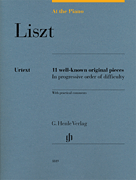
-
Liszt, Franz
Liszt: At the Piano (Hewig-Troescher)
11 Well-Known Original Pieces in Progressive Order of Difficulty. Contents: Sehr langsam from Four Piano Pieces; Andantino from Four Piano Pieces; Andante con moto from Consolations; Un poco pi mosso from Consolations; Quasi adagio; cantabile con devzione from Consolations; Hymne de l'enfant a son reveil from Harmonies potiques et religieuses; Le mal due pays from Annes de Plerinage, Premire Anne - Suisse; Il penseroso from Annes de Pelerinage, Deuxieme Annee - Italie; Canzonetta del Salv...
Read More
Category: Piano Composer Folios
Item: 115357
Grade:
Price: $19.95
Availability: Ships in 10 to 15 Days - View Shopping Cart
-

-
Liszt, Franz
Masterpieces for Solo Piano - 13 Works (Busoni et al)
Category: Piano Composer Folios
Item: 041818
Grade:
Price: $10.95
Availability: Ships in 6 to 9 Days - View Shopping Cart
-

-
Liszt, Franz
Mephisto Waltz (Giglberger/Gertsch)
Romantic. Edited by Norbert Gertsch & Veronika Giglberger. When Liszt took over the direction of the Court Opera in Weimar, he spent a great deal of time exploring Goethe's works. He was particularly attracted to the subject-matter of Faust. He used Nikolaus Lenau's "Faust", a comprehensive poem in 24 scenes, as the model for his orchestral work in two parts "Episodes from Lenau's Faust". The second part, "Dance in the Village Inn", was originally written for piano solo. He gave this wild piece w...
Read More
Category: Piano Solos
Item: 073893
Grade:
Price: $16.95
Availability: Ships in 6 to 9 Days - View Shopping Cart
-

-
Liszt, Franz
Mephisto Waltz, etc.
Category: Piano Solos
Item: 021837
Grade:
Price: $15.95
Availability: Ships in 6 to 9 Days - View Shopping Cart
-

-
Liszt, Franz
Piano Works - Supplementary Works (Kaczmarczyk/Mezo)
Includes Album d'un Voyageur I, III; Clochette; Carnival de Venise. 166 pages.
Category: Piano Composer Folios
Item: 067919
Grade:
Price: $47.95
Availability: Ships in 6 to 9 Days - View Shopping Cart
-

-
Liszt, Franz
Piano Works, v.14 - Weihnachtsbaum, Annes, Troisieme etc. (Adrienne)
Once Editio Musica Budapest had published critical editions of the complete piano solo works of Franz Liszt, they began work on a Supplement Series with the goal of publishing earlier and alternative editions of those works. Now in Volume 14, the editorspresent two alternate versions of the seminal Weihnachtsbaum: the first version (from autograph) and an early published version. Included also are alternate versions of his Annees de pelerinage, Troisieme annee and the Schlummerlied im Grabe, Die ...
Read More
Category: Piano Composer Folios
Item: 122357
Grade:
Price: $79.00
Availability: Ships in 6 to 9 Days - View Shopping Cart
-
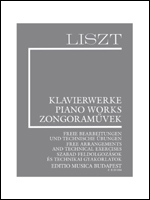
-
Liszt, Franz
Piano Works, v.16 - Free Arrangements & Technical Exercises (Kaczmarczyk/Sas/Defetel)
Supplementary Volume 16 of the New Liszt Edition contains free arrangements and technical exercises. In the first section can be found early versions of three arrangements. The first consists of the first and intermediary versions of a transcription of Die Rose, a song Schubert composed to a poem by Schlegel. The arrangement of the second movement of Berlioz's Harold Symphony also draws on literary inspiration: Lord Byron's (1788-1824) narrative poem Childe Harold's Pilgrimage (1812-18) was a lit...
Read More
Category: Piano Composer Folios
Item: 132949
Grade:
Price: $79.99
Availability: Usually Ships in 24 Hours - View Shopping Cart
-

-
Liszt, Franz
Procession By Night & Mephisto Waltz No 1 (Howard)
Subtitled, "Two Episodes from Lenau's Faust," this small collection contains "The Procession by Night" and "Mephisto Waltz No 2."
Category: Piano Composer Folios
Item: 069843
Grade: Advanced
Price: $19.95
Availability: Ships in 10 to 15 Days - View Shopping Cart
-
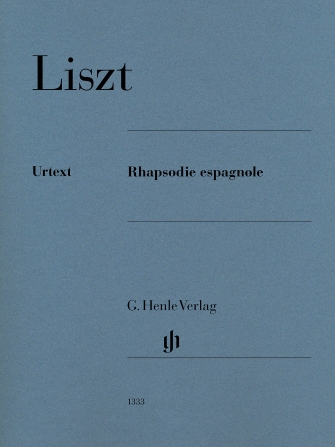
-
Liszt, Franz
Rhapsodie Espagnole (Heinemann/Eckhardt)
Romantic. Liszt's piano rhapsodies stand in the tradition of his transcriptions of operatic or song melodies, yet employ folk dances and songs as their source material. Completed in 1864, Rhapsodie espagnole is a late reminiscence of Liszt's extended travels to Spain and Portugal in 1844-45. On the basis of two popular Iberian dance tunes, Folia and Jota, Liszt here sets off fireworks of representative rhythms and tone colours with a highly virtuosic presto finale. The long inaccessible autograph...
Read More
Category: Piano Solos
Item: 125186
Grade:
Price: $16.95
Availability: Ships in 10 to 15 Days - View Shopping Cart
-

-
Liszt, Franz
Rigoletto Concert Paraphrase (Scheideler/Hamelin)
Category: Piano Solos
Item: 087617
Grade:
Price: $12.95
Availability: Ships in 6 to 9 Days - View Shopping Cart
-

-
Liszt, Franz
Schubert Song Transcriptions, v.3
Contains the complete Schwanengesang. Contents; Brilliant transcriptions by the foremost pianist-composer of his day of all 14 songs in the series, including such masterpieces as "Das Fischermdchen," "Am Meer," "Abschied," "Stndchen," "Frhlings-Sehnsucht," "Der Doppelgnger," and other famed lieder. All meticulously reproduced from rare early editions overseen by Liszt himself. - the publisher (contents & sample pages) ...
Read More
Category: Piano Composer Folios
Item: 034970
Grade:
Price: $16.95
Availability: Ships in 6 to 9 Days - View Shopping Cart
-
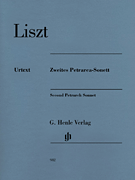
-
Liszt, Franz
Second Petrarch Sonnet
Category: Piano Solos
Item: 083890
Grade:
Price: $6.95
Availability: Ships in 6 to 9 Days - View Shopping Cart
-

-
Liszt, Franz
Selected Easy Pieces
Category: Piano Composer Folios
Item: 031619
Grade:
Price: $23.95
Availability: Ships in 6 to 9 Days - View Shopping Cart
-
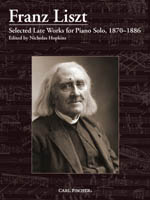
-
Liszt, Franz
Selected Late Works for Piano Solos, 1870-1886 (Hopkins)
Nicholas Hopkins has carefully selected and edited this collection of 30 late piano works by Franz Liszt, many of which remained unknown and unperformed into the late twentieth century. Also included is a scholarly essay which discusses the influences oflife events on the composer's work as well as analyses that demonstrate the musical originality in many of these pieces. The singularity and power of this music owe as much to its stylistic originality as to the external forces that influenced it....
Read More
Category: Piano Composer Folios
Item: 122137
Grade:
Price: $28.99
Availability: Ships in 6 to 9 Days - View Shopping Cart
-
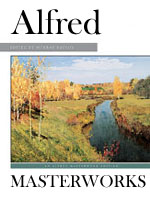
-
Liszt, Franz
Selected Solos (Hinson)
Category: Piano Composer Folios
Item: 008718
Grade:
Price: $9.95
Availability: Ships in 6 to 9 Days - View Shopping Cart
-

-
Liszt, Franz
Selected Works (21), w/Audio (Banowetz)
Category: Piano Composer Folios
Item: 062330
Grade:
Price: $14.95
Availability: Ships in 6 to 9 Days - View Shopping Cart
-

-
Liszt, Franz
Soirees de Vienne (Complete)
Category: Piano Composer Folios
Item: 106168
Grade:
Price: $14.95
Availability: Ships in 10 to 15 Days - View Shopping Cart
-

-
Liszt, Franz
Solos (9), v.5 (Escandon)
Category: Piano Composer Folios
Item: 022906
Grade:
Price: $19.95
Availability: Ships in 6 to 9 Days - View Shopping Cart
-

-
Liszt, Franz
Solos, v.1 (Escandon)
Category: Piano Composer Folios
Item: 020937
Grade:
Price: $19.95
Availability: Ships in 6 to 9 Days - View Shopping Cart
-

-
Liszt, Franz
Solos, v.3 (Escandon)
Category: Piano Composer Folios
Item: 022240
Grade:
Price: $19.95
Availability: Ships in 6 to 9 Days - View Shopping Cart
-
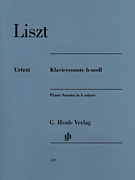
-
Liszt, Franz
Sonata in Bb (Hamelin/Herrtrich)
Following the revision of Henle's facsimile of ) in 2015, they now present the corresponding new Urtext edition. With the help of the splendid facsimile reproduction they were able to analyze several passages in the autograph more reliably; in addition the editor Ernst Herttrich not only consulted the first edition but also a copy of a student of Liszt's, in which the composer had made entries in his own hand. Clara Schumann reacted with a lack of understanding when Liszt commented: "It is only b...
Read More
Category: Piano Solos
Item: 112403
Grade:
Price: $16.95
Availability: Ships in 10 to 15 Days - View Shopping Cart
-

-
Liszt, Franz
Sonata in Bm (Bricard)
Romantic piano virtuoso and composer Franz Liszt's Sonata in B Minor is a monumental contribution to piano literature. This critical edition addresses sources, discrepancies, and performance issues (tempi, pedaling, fingering, style, interpretation, and technique). Also discussed are Liszt's life, career, and background on the historical, cultural, and social environment that influenced the composer.
Category: Piano Composer Folios
Item: 089680
Grade: Grade 6 - Advanced
Price: $10.99
Availability: Ships in 10 to 15 Days - View Shopping Cart
-

-
Liszt, Franz
Sonata in Bm (Howard)
Category: Piano Solos
Item: 093379
Grade:
Price: $14.50
Availability: Ships in 10 to 15 Days - View Shopping Cart
-

-
Liszt, Franz
Sonata in Bm (Kube)
Category: Piano Solos
Item: 101385
Grade:
Price: $19.95
Availability: Ships in 10 to 15 Days - View Shopping Cart
-
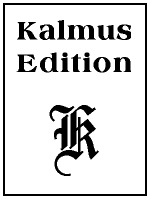
-
Liszt, Franz
Sonata in Bm
Category: Piano Solos
Item: 011526
Grade:
Price: $8.95
Availability: Ships in 6 to 9 Days - View Shopping Cart
-

-
Liszt, Franz
Sonata in Bm (Herrtrich/Theopold)
G. Henle URTEXT edition
Category: Piano Solos
Item: 013852
Grade:
Price: $19.95
Availability: Ships in 6 to 9 Days - View Shopping Cart
-

-
Liszt, Franz
Sonetto 104 Del Petrarca (Joseffy)
Category: Piano Solos
Item: 122270
Grade:
Price: $3.95
Availability: Ships in 10 to 15 Days - View Shopping Cart
- p.1 (Aa - Al)
- p.2 (Al - At)
- p.3 (At - Ba)
- p.4 (Ba - Ba)
- p.5 (Ba - Ba)
- p.6 (Ba - Ba)
- p.7 (Ba - Ba)
- p.8 (Ba - Ba)
- p.9 (Ba - Ba)
- p.10 (Ba - Ba)
- p.11 (Ba - Be)
- p.12 (Be - Be)
- p.13 (Be - Be)
- p.14 (Be - Be)
- p.15 (Be - Be)
- p.16 (Be - Be)
- p.17 (Be - Be)
- p.18 (Be - Bo)
- p.19 (Bo - Br)
- p.20 (Br - Br)
- p.21 (Br - Bu)
- p.22 (Bu - Ch)
- p.23 (Ch - Ch)
- p.24 (Ch - Ch)
- p.25 (Ch - Ch)
- p.26 (Ch - Ch)
- p.27 (Ch - Cl)
- p.28 (Cl - Co)
- p.29 (Co - Cz)
- p.30 (Cz - Da)
- p.31 (Da - De)
- p.32 (De - De)
- p.33 (De - De)
- p.34 (De - Du)
- p.35 (Du - En)
- p.36 (En - Fo)
- p.37 (Fr - Ge)
- p.38 (Gi - Gr)
- p.39 (Gr - Gr)
- p.40 (Gr - Gu)
- p.41 (Gu - Ha)
- p.42 (Ha - Ha)
- p.43 (Ha - Ha)
- p.44 (Ha - He)
- p.45 (He - Hy)
- p.46 (Ia - Jo)
- p.47 (Jo - Ka)
- p.48 (Ka - Ko)
- p.49 (Ko - La)
- p.50 (La - Li)
- p.51 (Li - Li)
- p.52 (Li - Li)
- p.53 (Li - Ma)
- p.54 (Ma - Mc)
- p.55 (Mc - Me)
- p.56 (Me - Mo)
- p.57 (Mo - Mo)
- p.58 (Mo - Mo)
- p.59 (Mo - Mo)
- p.60 (Mo - Na)
- p.61 (Ne - Pa)
- p.62 (Pa - Pl)
- p.63 (Pl - Pr)
- p.64 (Pr - Ra)
- p.65 (Ra - Ra)
- p.66 (Ra - Ra)
- p.67 (Ra - Ri)
- p.68 (Ri - Ro)
- p.69 (Ro - Sa)
- p.70 (Sa - Sc)
- p.71 (Sc - Sc)
- p.72 (Sc - Sc)
- p.73 (Sc - Sc)
- p.74 (Sc - Sc)
- p.75 (Sc - Sc)
- p.76 (Sc - Sc)
- p.77 (Sc - Sh)
- p.78 (Sh - Sn)
- p.79 (Sn - St)
- p.80 (St - Sz)
- p.81 (Ta - Tc)
- p.82 (Tc - Tu)
- p.83 (Tu - Va)
- p.84 (Va - Va)
- p.85 (Va - Va)
- p.86 (Va - Va)
- p.87 (Va - Va)
- p.88 (Va - Va)
- p.89 (Va - Va)
- p.90 (Va - Va)
- p.91 (Va - Va)
- p.92 (Va - Va)
- p.93 (Va - Va)
- p.94 (Va - Va)
- p.95 (Va - Va)
- p.96 (Va - Va)
- p.97 (Va - Vi)
- p.98 (Vi - We)
- p.99 (We - Za)
- p.100 (Za - Zy)
- Next >
More Options
- Use our Custom Order Page to special order items you can't find.
- Use our Catalog Order Page to order items from a printed catalog, or if you already know our catalog number for the item(s) you're interested in.
- And as always, feel free to E-mail us with your questions!
